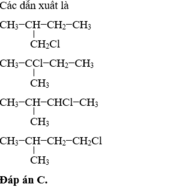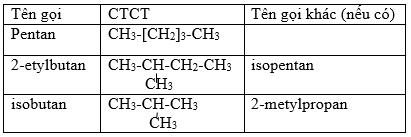Hãy nhập câu hỏi của bạn vào đây, nếu là tài khoản VIP, bạn sẽ được ưu tiên trả lời.

a) CH3COONa + NaOH\(\xrightarrow[t]{CaO}\) CH4 + Na2CO3
CH4+ Cl2 -> CHCl3 +HCl
b) C4H10 \(\xrightarrow[xt]{t}C_3H_6+CH_4\)
CH4 + O2-> CO2 +H2O
CO2 +Ca(OH)2-> CaCO3 +H2O
C) Al4C3 + H2O -> Al(OH)3 + CH4
CH4 \(\xrightarrow[lamlanhnhanh]{1500^0}\) C2H2 +H2
p/s: làm tới đây thôi ,tự cân bằng

\(a.CH_3-CH\left(CH_3\right)-CH_2-CH_3\\ b.\left(CH_3\right)_3-C-CH_2-CH_3\)

\(a.\)
\(CH_3-CH_2-CH_2-CH_2-CH_3\)
\(CH_3-CH\left(CH_3\right)-CH_2-CH_3\)
\(b.\)
\(CH_3-CH\left(CH_3\right)-CH_3\)
\(CH_3-\left(CH_3\right)C\left(CH_3\right)-CH_2-CH_3\)
\(c.\)
\(CH_3-CH\left(CH_3\right)-CH_2-CH_3\)
\(d.\)
\(\left(CH_3\right)_4C\)
\(e.\)
\(C-C-C\left(C_2H_5\right)-CH_2-CH_3\)
\(f.\)
\(CH_3-CH\left(CH_3\right)-CH\left(CH_3\right)-CH_2-CH_3\)

Hai chất 2,2 - đimetyl butan và 2,3 - đimetyl butan là:
A. Ankan. B. Đồng phân. C. Đồng đẳng. D. A và B.
Vì: Do hai chất này trong phân tử chỉ chứa nối đơn => là RH no => ankan
Do 2 chất này có PTK bằng nhau và có tình chất hoá học tương tự nhau ( vì chỉ thay đổi vị trí đính metyl ở C số 2 và 3 ) nên chúng là đồng phân của nhau.

1.\(CH_2Cl-CH-CH\left(CH_3\right)-CH_2-CH_3\)
1-clo-3-metylpentan
2.\(CH_2-CH_2-CH\left(CH_3\right)-CH_3\)
2-metylbutan
3.\(CH_3-CH\left(CH_3\right)-CH_2-CH\left(CH_3\right)-CH_2-CH_3\)
2,4-đimetylhexan

Câu 1 : Qua nhận xét về phân tử khối và liên kết hidro trong mỗi hợp chất, ta có :
Thứ tự : Axit > Ancol > Este > Hidrocacbon
Ta thấy : Glyxin ở dạng ion lưỡng cực nên có nhiệt độ sôi cao hơn axit propionic
Vậy, theo chiều tăng dần nhiệt độ sôi, nhiệt độ nóng chảy là :
Glyxin > Axit propionic > Butan-1-ol >Metyl axetat > Butan





Chọn D.
(X) : iso-pentan ; (Y) : n-butan ; (P) : iso-butan ; (Q) : n-pentan